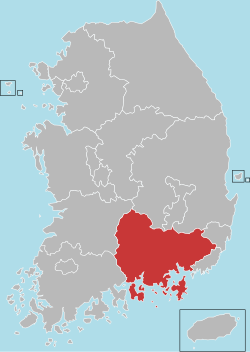South Gyeongsang Province
South Gyeongsang Province
경상남도 | |
|---|---|
| Korean transcription(s) | |
| • Hangul | 경상남도 |
| • Hanja | 慶尙南道 |
| • McCune‑Reischauer | Kyŏngsang-namdo |
| • Revised Romanization | Gyeongsangnam-do |
 | |
| Coordinates: 35°15′N 128°15′E / 35.250°N 128.250°E | |
| Country | South Korea |
| Region | Yeongnam |
| Capital | Changwon |
| Subdivisions | 8 cities; 10 counties |
| Government | |
| • Governor | Kim Kyoung-soo (Democratic) |
| Area | |
| • Total | 10,533 km2 (4,067 sq mi) |
| • Rank | 4th |
| Population (December, 2018) | |
| • Total | 3,447,687 |
| • Rank | 2nd |
| • Density | 327.86/km2 (849.2/sq mi) |
| Metropolitan Symbols | |
| • Flower | Rose |
| • Tree | Zelkova |
| • Bird | White heron |
| ISO 3166 code | KR-48 |
| Dialect | Gyeongsang |
South Gyeongsang Province (Korean: 경상남도, romanized: Gyeongsangnam-do, Korean pronunciation: [kjʌŋ.saŋ.nam.do]) is a province in the southeast of South Korea. The provincial capital is at Changwon. It is adjacent to the major metropolitan center and port of Busan. There is UNESCO World Heritage Site Haeinsa, a Buddhist temple that houses the Tripitaka Koreana and attracts many tourists. Automobile and petrochemical factories are largely concentrated along the southern part of the province, extending from Ulsan through Busan, Changwon, and Jinju.
Etymology
The name derives from Korean Gyeongsang 'joyous furthermore'; from gyeong (Korean 경, Hanja 慶) 'happy' and sang (Korean 상, Hanja 尚) 'still more'. The name derives from the names of the principal cities of Gyeongju (경주; 慶州) and Sangju (상주; 尙州).
History
Before 1895, the area corresponding to modern-day South Gyeongsang Province was part of Gyeongsang Province, one of the Eight Provinces of Korea during the Joseon. In 1895, southern Gyeongsang was replaced by the districts of Jinju in the west and Dongnae (modern-day Busan) in the east. In 1896, they were merged to form South Gyeongsang Province.
The provincial capital was originally at Jinju; it moved in 1925 to Busan. In 1948, South Gyeongsang Province became part of South Korea. In 1963, Busan separated from South Gyeongsang Province to become a Directly Governed City (Jikhalsi). In 1983, the provincial capital moved from Busan to Changwon.
In 1995, Busan became a Metropolitan City (Gwangyeoksi), and Ulsan separated from South Gyeongsang Province to become a Metropolitan City in 1997.
Geography
The province is part of the Yeongnam region, on the north by North Gyeongsang Province, on the west by North Jeolla Province and South Jeolla Province, and on the south by the Korea Strait far from Nagasaki Prefecture, Japan. Most of the province is drained by the Nakdong River and its tributaries. The total area of the province is 10,533 square kilometres (4,067 sq mi).[1]
Resources
The Nakdong delta plain around Gimhae is one of the best granaries in South Korea. Agricultural products form Gyeongsangnam-do include rice, beans, potatoes, and barley. The area is renowned for its cotton, sesame, and fruits which are grown along the southern seaside. A number of marine products are caught. The province is one of the country's leading fisheries.
Major cities
The largest cities in the region are Busan and Ulsan, which are separately administered as provincial-level Metropolitan Cities. Apart from the capital Changwon, other large or notable cities include Gimhae and Jinju.
Attractions

Gyeongsangnam-do is the home of Haeinsa, a Buddhist temple that houses the Tripitaka Koreana and attracts many tourists. It is in the national park around Jirisan (1,915 m) on the border with Jeollabuk-do. The temple was first built in 802.
Changnyeong County contains three major tourist attractions for the province: Upo Wetland, the natural hotsprings of Bugok, and Hwawangsan.
Yangsan-si contains two major temples for the province: Tongdosa and Naewon Temple
Administrative divisions



Gyeongsangnam-do is divided into 8 cities (si) and 10 counties (gun). The names below are given in English, hangul, and hanja.
| Map | # | Name | Hangul | Hanja | Population (2012)[2] | Subdivisions |
|---|---|---|---|---|---|---|

| ||||||
| — Specific City — | ||||||
| 1 | Changwon | 창원시 | 昌原市 | 1,106,081 | 5 ilban-gu — 2 eup, 6 myeon, 54 haengjeong-dong | |
| 2 | Gimhae | 김해시 | 金海市 | 531,383 | 1 eup, 6 myeon, 12 haengjeong-dong | |
| — City — | ||||||
| 3 | Jinju | 진주시 | 晉州市 | 341,221 | 1 eup, 15 myeon, 15 haengjeong-dong | |
| 4 | Yangsan | 양산시 | 梁山市 | 274,770 | 1 eup, 4 myeon, 8 haengjeong-dong | |
| 5 | Geoje | 거제시 | 巨濟市 | 245,972 | 9 myeon, 10 haengjeong-dong | |
| 6 | Tongyeong | 통영시 | 統營市 | 143,039 | 1 eup, 6 myeon, 8 haengjeong-dong | |
| 7 | Sacheon | 사천시 | 泗川市 | 117,968 | 1 eup, 7 myeon, 6 haengjeong-dong | |
| 8 | Miryang | 밀양시 | 密陽市 | 109,967 | 2 eup, 9 myeon, 5 haengjeong-dong | |
| — County — | ||||||
| 9 | Haman County | 함안군 | 咸安郡 | 70,443 | 2 eup, 8 myeon | |
| 10 | Geochang County | 거창군 | 居昌郡 | 63,536 | 1 eup, 11 myeon | |
| 11 | Changnyeong County | 창녕군 | 昌寧郡 | 64,297 | 2 eup, 12 myeon | |
| 12 | Goseong County | 고성군 | 固城郡 | 58,553 | 1 eup, 13 myeon | |
| 13 | Namhae County | 남해군 | 南海郡 | 48,899 | 1 eup, 9 myeon | |
| 14 | Hapcheon County | 합천군 | 陜川郡 | 50,713 | 1 eup, 16 myeon | |
| 15 | Hadong County | 하동군 | 河東郡 | 51,235 | 1 eup, 12 myeon | |
| 16 | Hamyang County | 함양군 | 咸陽郡 | 41,155 | 1 eup, 10 myeon | |
| 17 | Sancheong County | 산청군 | 山淸郡 | 36,079 | 1 eup, 10 myeon | |
| 18 | Uiryeong County | 의령군 | 宜寧郡 | 31,027 | 1 eup, 12 myeon | |
Religion
Religion in South Gyeongsang (2005)[3]
According to the census of 2005, of the people of South Gyeongsang 40% follow Buddhism and 14.8% follow Christianity (8.8% Protestantism and 6% Catholicism).[3] 45.2% of the population is mostly not religious or follow Muism and other indigenous religions.
Sister districts
 Yamaguchi Prefecture (July 26, 1987)
Yamaguchi Prefecture (July 26, 1987) Maryland (November 18, 1991)
Maryland (November 18, 1991) Shandong (September 8, 1993)
Shandong (September 8, 1993) East Java (May 9, 1996)
East Java (May 9, 1996) Đồng Nai Province (September 1, 1996)
Đồng Nai Province (September 1, 1996) Khabarovsk Krai (September 14, 1996)
Khabarovsk Krai (September 14, 1996) Jalisco (March 10, 1997)
Jalisco (March 10, 1997) Laguna province (April 15, 1997)
Laguna province (April 15, 1997) Pomeranian Voivodeship (April 22, 1997)
Pomeranian Voivodeship (April 22, 1997) Fejér County (April 24, 1997)
Fejér County (April 24, 1997)
See also
- List of Korea-related topics
- Igeum-dong site - complex archaeological site in Sacheon-si
- Gyeongsang National University
- Tongyeong International Music Festival

References
- ^ 일반 현황 (in Korean). South Gyeongsang Province. Retrieved 18 March 2013.
- ^ "Population of Gyeongsangnam-do" (in Korean). Gyeongsangnam-do. Archived from the original on 2014-02-25. Retrieved 2013-07-16.
- ^ a b "2005 Census - Religion Results". Archived from the original on 2015-09-04.
External links
 South Gyeongsang travel guide from Wikivoyage
South Gyeongsang travel guide from Wikivoyage- Official website
 (in English)
(in English)



